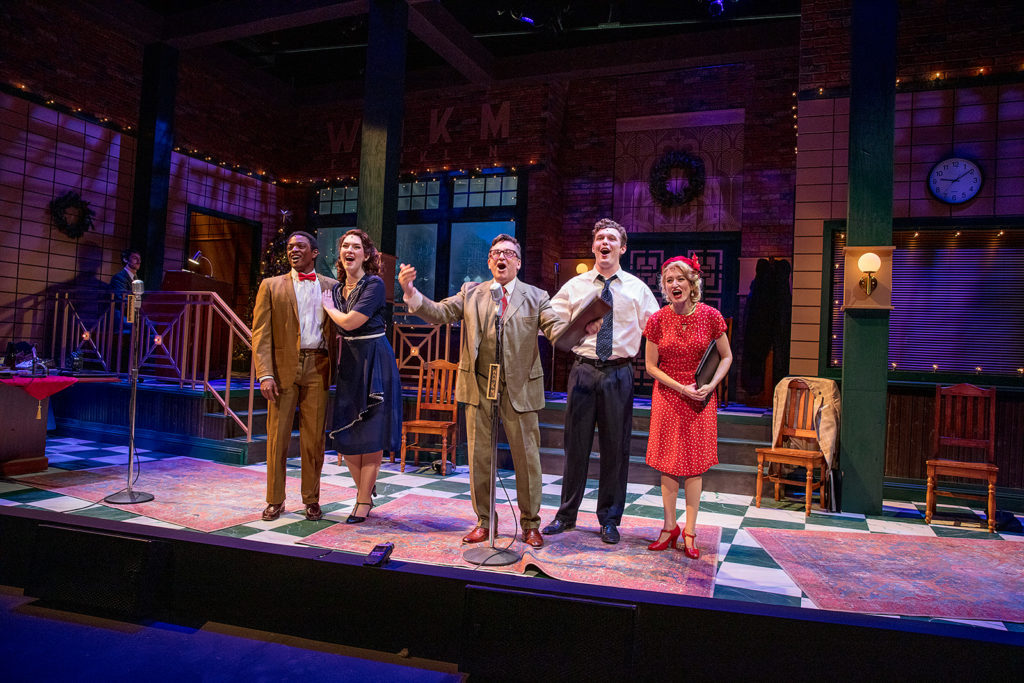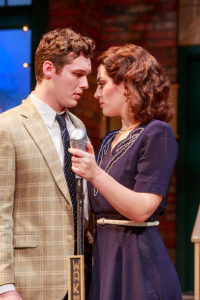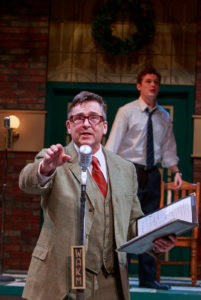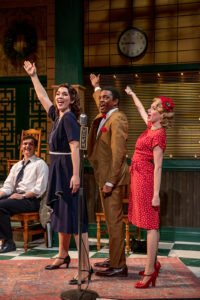
“Every time a bell rings, an angel gets his wings.” Perhaps one of the most well-known, and certainly one of the most beloved lines ever written for a film. Of course that film is Frank Capra’s 1946 touching drama, It’s a Wonderful Life, based on Phillip Van Doren Stern’s 1943 short story, The Greatest Gift. For their holiday offering, and their return to full production with a full in-person audience after nearly two years of what we can all agree upon wasn’t exactly a wonderful life, Studio Tenn is back at Jameson Hall in The Factory at Franklin with playwright Joe Landry’s stage adaptation It’s a Wonderful Life: A Live Radio Play which opened December 9 and will present a final performances the remainder of this week, including a closing matinee of Christmas Eve, December 24.
When I attended the show last week, as I walked into Jameson Hall, I fully expected a wave of emotion to sweep over me, having missed my favorite theatre company more than I can fully express here. I asked the usher about a playbill and she pointed towards a stack of what looked like a local daily newspaper. Yes, even the program sets the mood, as it’s printed courtesy the Williamson Herald, Franklin’s local paper. What’s more, the playbill has the appearance of a special edition. Upon entering the theatre space itself, that nostalgic ambiance kicked into high gear thanks to scenic designer Andrew Cohen, tech director Mitch White and the team of electricians, carpenters and crew, Jameson Hall has been transformed into a perfectly idyllic version of WAKM AM 950, Franklin’s oldest continuing radio station. Nerd that I am, I feel compelled to mention that the play takes place Christmas Eve, 1946, and while WAKM is indeed Franklin’s oldest radio station, it wasn’t founded until the early 50s, but I digress. Aiding in the transformation to mid-century fictional Bedford Falls, the show is peppered with a few radio commercial spots, highlighting the actual sponsors of Studio Tenn’s production. And yes, the commercials do indeed include a couple of swell jingles.
If you’ve seen the film, and honestly, I’d be very concerned with your entire being if you haven’t, you know It’s a Wonderful Life is the story of George Bailey, a young man who’s always been there for his family, often sacrificing his own hopes and dreams for the sake of others, who, when life gets to be too much, contemplates taking a fatal plunge off a bridge, but whose near-fatal act is thwarted by a guardian angel who shows him that while life is indeed filled with heart-wrenching challenges, in the end, it is indeed the wonderful aspect of it that make it worth living.
That’s right, one of the holiday’s most beloved stories deals with some heady subject matter. Oh wait, there’s more. Along his life’s journey George saves his brother from drowning, presents his pharmacist employer from accidentally poisoning a customer, faces bankruptcy, turns to the bottle and risks his marriage. But here’s the thing, Capra and company, and with this iteration, Landry, craft all these serious happenings with such heart, compassion and a healthy sprinkling of humor that you can’t help but love this story.
As the action began, the small cast of five actors: Caleb Shore, Gerold Oliver, Matthew Carlton, Galen Crawley and Marian Parris, and on-stage piano accompanist Mitchell Beard appear onstage as their characters arrive at work to the radio station on Christmas Eve to perform a live radio play for their listeners. The audience, then becomes the equivalent of a studio audience for the radio play. The inclusion of applause signs that occasionally light up just adds to the nostalgia and the illusion.
Among the first to arrive is Jake Laurentis, played by Shore. As he settles in for his performance as George Bailey, he’s seen walking around the radio station’s recording booth casually checking out the various items used as sound effects for the broadcast. First he picks up a pair of shoes and taps the soles together a few times. Yes, that’s exactly how radio dramas would give the illusion of a character walking in and out of a room. Then he reaches for a tiny bell on the end of the foley table and gently rings it. Maybe it was the emotion and anticipation of seeing my first straight play after nearly two years. Maybe I’m just a sucker at heart. Or maybe I’m like Pavlov’s dog, but from the first tinkling of that bell, which of course immediately reminded me of the aforementioned beloved line of dialogue, to that final curtain bows, I was a weeping, crying mess, or as my dear uncle would say, my eyes were ‘sweating’ the entire time. Thank goodness for Studio Tenn’s covid safety compliance and required face mask policy. At least my tears fell into the mask and only my date for the day saw me crying.
Of course it wasn’t just the Pavlovian bell that rang true, but also the performances of the entire cast. In most theatrical performances, it would seen challenging enough to play a single character, but in a show like this, the actors are charged, not only with their primary character, but being a radio play within a play, they’re also entrusted with playing the townsfolk of the fictional Bedford Falls once that “On Air” sign illuminates. Given the immense popularity and consciousness-saturating of the source material for the last 70-something years, it would seem quite the undertaking to mount such a popular and well-known story, whose characters seem engrained in our brains thanks to the revered film.
 Shore, as George Bailey, the character iconically portrayed by Jimmy Stewart in the film is simply splendid. Being only slightly familiar with Shore through mutual friends in the film and television world, I knew he’d be great, if for no other reason than the fact that his natural speaking voice is perfectly similar to the beloved low-tones and occasional hesitations of Stewart himself. Under the watchful, skilled eye of Patrick Cassidy, Artistic Director at Studio Tenn and the show’s director, Shore’s George Bailey is blissfully perfect. He teases the audience with the Stewartisms, but never to the point of mimic or impersonation, expertly conveying both the beloved actor’s treasured original, while simultaneously making the role his own. Early in the radio play, when Shore is portraying a very young George, the timidity in his voice builds the anticipation of the George Bailey to come.
Shore, as George Bailey, the character iconically portrayed by Jimmy Stewart in the film is simply splendid. Being only slightly familiar with Shore through mutual friends in the film and television world, I knew he’d be great, if for no other reason than the fact that his natural speaking voice is perfectly similar to the beloved low-tones and occasional hesitations of Stewart himself. Under the watchful, skilled eye of Patrick Cassidy, Artistic Director at Studio Tenn and the show’s director, Shore’s George Bailey is blissfully perfect. He teases the audience with the Stewartisms, but never to the point of mimic or impersonation, expertly conveying both the beloved actor’s treasured original, while simultaneously making the role his own. Early in the radio play, when Shore is portraying a very young George, the timidity in his voice builds the anticipation of the George Bailey to come.
Alongside Shore as the only other performer to not subsequently portray a multitude of characters in the show within the show is Mariah Parris as Sally Applewhite, who in turn voices Mary Bailey, George’s Wonderful Life wife. Parris may be familiar to local theateratti having appeared in Nashville Repertory Theatre’s Urinetown, as well as Nashville Shakespeare Festival’s Macbeth as the Lady, herself. Parris’ Mary Hatch is the quintessential mid-century woman. Content with home and family, but with a palpable passion for life and all it has to offer. Speaking of passion, the scene when George is shyly courting Mary at her home and she receives a phone call from another suitor, Sam Wainwright, who just happens to be one of George’s pals, is so unexpected bubbling with chemistry. In the film, the two hold the telephone receiver between them. Under Cassidy’s detail-rich direction, and with this being a radio play the two stand breath-to-breath at the microphone as they listen to Sam blather on. I swear, even I got lost in the palpably executed spark between the two and couldn’t tell you a thing about the phone call itself. Chemistry, direction and execution…it’s all there in that one scene and thankfully, throughout the show.
 As for the rest of the players–who tackle among them, somewhere around half a dozen characters each–they are Matthew Carlton, Galen Crawley and Gerold Oliver. Carlton, who is, in my humble estimation, the Grand Duke of Theatre ‘round here, plays radio personality Freddy Filmore. Alright, if you know me at all, you know I’m a huge Lucille Ball fan and collector, and if you’re a fellow Baller (yes, I just coined that because it’s hilarious), you, too will recognize the name Freddy Filmore, for that’s the character’s name in a particularly funny episode of I Love Lucy in which Lucy appears on a radio game show Females are Fabulous! Now, I’ve seen previous productions of It’s A Wonderful Life: A Live Radio Play, but I’ve somehow never noticed this character’s name before. Heck, it’s even in the play when he’s introduced that he’s the host of Females are Fabulous. How have I missed this? But back to the play…as Filmore, Carlton gives voice to the Angel Joseph, who assigns AS2 Clarence to George’s predicament. Among the other characters Carlton brings to life in the radio drama, he’s also the villainous Mr. Potter, George’s kind but bumbling Uncle Billy. To that end, I’ve never been more entertained by Carlton than when he’s in a scene with himself as Potter and Bill. Not only does he do this by the expected turning from side to side as his dual characters confront each other, but his physicality, mannerisms and even his facial expressions drastically change, helping the audience keep up. I mean, you can never have too much Matthew Carlton on stage, so seeing him bring a multitude of characters to life is indeed a joyous occasion.
As for the rest of the players–who tackle among them, somewhere around half a dozen characters each–they are Matthew Carlton, Galen Crawley and Gerold Oliver. Carlton, who is, in my humble estimation, the Grand Duke of Theatre ‘round here, plays radio personality Freddy Filmore. Alright, if you know me at all, you know I’m a huge Lucille Ball fan and collector, and if you’re a fellow Baller (yes, I just coined that because it’s hilarious), you, too will recognize the name Freddy Filmore, for that’s the character’s name in a particularly funny episode of I Love Lucy in which Lucy appears on a radio game show Females are Fabulous! Now, I’ve seen previous productions of It’s A Wonderful Life: A Live Radio Play, but I’ve somehow never noticed this character’s name before. Heck, it’s even in the play when he’s introduced that he’s the host of Females are Fabulous. How have I missed this? But back to the play…as Filmore, Carlton gives voice to the Angel Joseph, who assigns AS2 Clarence to George’s predicament. Among the other characters Carlton brings to life in the radio drama, he’s also the villainous Mr. Potter, George’s kind but bumbling Uncle Billy. To that end, I’ve never been more entertained by Carlton than when he’s in a scene with himself as Potter and Bill. Not only does he do this by the expected turning from side to side as his dual characters confront each other, but his physicality, mannerisms and even his facial expressions drastically change, helping the audience keep up. I mean, you can never have too much Matthew Carlton on stage, so seeing him bring a multitude of characters to life is indeed a joyous occasion.
 Galen Crawley plays radio ingenue, Lana Sherwood. Crawley, like Parris, might also be familiar to local theatre patrons for her work with Nashville Rep, having also appeared in their production of Urinetown, as well as The Last Five Years, but it’s this Studio Tenn debut that I’ll now forever remember her by. Compete with platinum blonde wig, a smart ensemble—courtesy the show’s costumer, Lauren Terry, whose nostalgic expertise wholly embodies the era for all the cast—and some gum-poppin’ to rival Jean Harlow, Crawley’s Lana easily voices Violet Bick. You remember that character. She’s the childhood friend of Mary and George, who, after admitting she likes George, Mary says, “You like every boy”, to which young Violet replies, “What’s wrong with that?” While her Violet is feisty and flirty, Crawley’s range as an actress comes through in a few of her other voiced characters, including George’s mother, Mrs. Bailey, but most notably as Zuzu Bailey, George and Mary’s youngest child. The audience knows we are looking at a grown woman, but Crawley’s childlike intonations and deliciously juvenile mannerisms are a bright spot throughout. Hopefully my face mask muffled not only my tears during the petal scene and the much-mentioned bell-ringing, but also my audible guffaw during the scene when the narrator mentions George and Mary’s children and Crawley not only voices the cries of the babies at birth, but physically bounds from one spot on stage to another to indicate the difference between Janie, the Bailey’s older daughter, and young Zuzu.
Galen Crawley plays radio ingenue, Lana Sherwood. Crawley, like Parris, might also be familiar to local theatre patrons for her work with Nashville Rep, having also appeared in their production of Urinetown, as well as The Last Five Years, but it’s this Studio Tenn debut that I’ll now forever remember her by. Compete with platinum blonde wig, a smart ensemble—courtesy the show’s costumer, Lauren Terry, whose nostalgic expertise wholly embodies the era for all the cast—and some gum-poppin’ to rival Jean Harlow, Crawley’s Lana easily voices Violet Bick. You remember that character. She’s the childhood friend of Mary and George, who, after admitting she likes George, Mary says, “You like every boy”, to which young Violet replies, “What’s wrong with that?” While her Violet is feisty and flirty, Crawley’s range as an actress comes through in a few of her other voiced characters, including George’s mother, Mrs. Bailey, but most notably as Zuzu Bailey, George and Mary’s youngest child. The audience knows we are looking at a grown woman, but Crawley’s childlike intonations and deliciously juvenile mannerisms are a bright spot throughout. Hopefully my face mask muffled not only my tears during the petal scene and the much-mentioned bell-ringing, but also my audible guffaw during the scene when the narrator mentions George and Mary’s children and Crawley not only voices the cries of the babies at birth, but physically bounds from one spot on stage to another to indicate the difference between Janie, the Bailey’s older daughter, and young Zuzu.
Rounding out the cast, and stealing virtually every moment he’s on stage is Gerold Oliver as Harry ‘Stacks’ Heywood. I first took note of Oliver back in 2017 when he lit up the stage as Seaweed in a local production of Hairspray. I next saw him in Chaffin’s Barn Dinner Theatre’s Annie. In more recent times, he appeared earlier this year in Nashville Shakespeare’s outdoor performance of August Wilson‘s Jitney. Here he plays Clarence, George’s heaven-sent guide through the various stages of his wonderful life, but Oliver also voices various townspeople, one of the Bailey’s sons, a brawl-lovin’ husband and Mr. Martini, the proprietor of a local bar. A favorite aspect of Oliver’s performance comes when he switches from one character to his primary role as Clarence. With the twinkling run of the scales of the xylophone atop the nearby foley table, regardless of where Oliver is on stage and what character he just voiced, he gets a focused look quickly moves to stand facing the audience and jumps right back into his Clarence persona. I’m certain my description doesn’t fully serve justice to just how exquisite those moments are.
It’s a Wonderful Life: A Live Radio Play is full of exquisite moments. From the gorgeous set, wigs and costumes, to the technical aspects of the show including musical accompaniment, lighting, sound design to the stage direction and excellent performances all ‘round, Studio Tenn’s return to full live production is proof positive indeed that it is indeed a wonderful life, and I for one am overcome with excitement to see what’s next as they’re set to soon announce the coming season.
It’s a Wonderful Life: A Live Radio Play concludes its holiday run with a final week of performances Tuesday, December 21 through Friday, December 24. Tuesday, Wednesday and Thursday evening performances are at 7p.m. with a 2p.m. Thursday matinee and the show’s final Friday performance a 2p.m. Christmas Eve matinee. CLICK HERE for tickets.
 Following It’s a Wonderful Life the theatre company will ring in the new year at The Franklin Theatre with New Year’s with Studio Tenn hosted by Patrick Cassidy with special musical guests, John Mark McGaha and Jackie Burns. CLICK HERE for tickets and more information.
Following It’s a Wonderful Life the theatre company will ring in the new year at The Franklin Theatre with New Year’s with Studio Tenn hosted by Patrick Cassidy with special musical guests, John Mark McGaha and Jackie Burns. CLICK HERE for tickets and more information.
Be sure to check out Studio Tenn online at StudioTenn.com or on social media at Facebook, Instagram and Twitter.
Interested in coverage for your latest entertaining endeavor? Click the contact page and drop me a note. You can also follow JHP Entertainment on Instagram and Facebook.